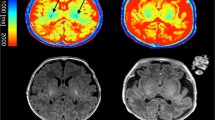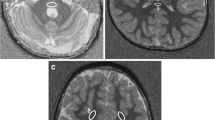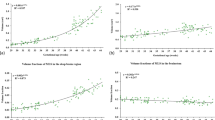Abstract
To study the progress of myelination in preterm-born subjects by measuring the MT ratio (MTR) from birth, up to 24 months of corrected age.One hundred twenty-five preterm subjects (64 males and 61 females of gestational age 33±2.4 weeks with chronologic and corrected age of 9.3±5.1 and 7.7±5.1 months, respectively) with normal brain MR using classic sequences were further evaluated for MTR by using a three-dimensional gradient-echo sequence (TR=32/TE=8/flip angle=6° 4 mm/2 mm overlapping sections) with and without magnetization transfer prepulse. The magnetization transfer ratio was calculated as: MTR=(SIo-SIm)/SIo×100%, where SIm refers to signal intensity from an image acquired with a MT prepulse and SIo the signal intensity from the image acquired without a MT prepulse. MTR increased asymptotically in the genu (R2=0.85) and splenium (R2=0.85) of the corpus callosum, the white matter of the frontal lobe (R2=0.91) and occipital lobe (R2=0.82), thalamus (R2=0.86), caudate nucleus (R2=0.67) and putamen (R2=0.71), reaching the 95% of the final value at the corrected age 18.7, 17.7, 15.6, 12.9, 10.4, 9.2 and 6.4 months, respectively. This study shows age-related changes of the brain MTR and provides data that may be useful to assess disturbances in the progress of myelination.
Access this article
We’re sorry, something doesn't seem to be working properly.
Please try refreshing the page. If that doesn't work, please contact support so we can address the problem.

Similar content being viewed by others
Explore related subjects
Discover the latest articles and news from researchers in related subjects, suggested using machine learning.References
Guyer B, Hoyert DL, Martin JA, Ventura SJ, MacDorman MF, Strobino DM (1999) Annual summary of vital statistics-1998. Pediatrics 104:1229–1246
Wood NS, Marlow N, Costeloe K, Gibson AT, Wilkinson AR (2000) Neurologic and developmental disability after extremely preterm birth. EPICure Study Group. N Engl J Med 343:378–384
Hack M, Taylor HG, Klein N, Mercuri-Minich N (2000) Functional limitations and special health care needs of 10- to 14-year-old children weighing less than 750 grams at birth. Pediatrics 106:554–560
Volpe JJ (2001) Neurobiology of periventricular leukomalacia in the premature infant. Pediatr Res 50:553–562
Barkovich JA (2000) Concepts of myelin and myelination in neuroradiology. Am J Neuroradiol 21:1099–1109
Argyropoulou MI, Xydis V, Drougia A, Argyropoulou PI, Tzoufi M, Bassounas A, Andronikou S, Efremidis SC (2003) MRI measurements of the pons and cerebellum in children born preterm; associations with the severity of periventricular leukomalacia and perinatal risk factors. Neuroradiology 45:730–734
Peterson BS, Vohr B, Staib LH, Cannistraci CJ, Dolberg A, Schneider KC, Katz KH, Westerveld M, Sparrow S, Anderson AW, Duncan CC, Makuch RW, Gore JC, Ment LR (2000) Regional brain volume abnormalities and long-term cognitive outcome in preterm infants. JAMA 284:1939–1947
Mehta RC, Pike GB, Enzmann DR (1995) Magnetization transfer MR of the normal adult brain. Am J Neuroradiol 16:2085–2091
Chew WM, Rowley HA, Barkovich AJ (1992) Magnetization transfer contrast imaging in pediatric patients. Radiology 185:281
Engelbrecht V, Rassek M, Preiss S, Wald C, Modder U (1998) Age-dependent changes in magnetization transfer contrast of white matter in the pediatric brain. Am J Neuroradiol 19:1923–1929
van Buchem MA, Steens SC, Vrooman HA, Zwinderman AH, McGowan JC, Rassek M, Engelbrecht V (2001) Global estimation of myelination in the developing brain on the basis of magnetization transfer imaging: a preliminary study. Am J Neuroradiol 22:762–766
Vavasour IM, Whittall KP, MacKay AL, Li DK, Vorobeychik G, Paty DW (1998) A comparison between magnetization transfer ratios and myelin water percentages in normals and multiple sclerosis patients. Magn Reson Med 40:763–768
Wolff SD, Balaban RS. Magnetization transfer imaging: practical aspects and clinical applications. Radiology 192:593–599
Argyropoulou MI, Kiortsis DN, Metafratzi Z, Efremidis SC (2001) Magnetisation transfer imaging of the normal adenohypophysis: the effect of sex and age. Neuroradiology 43:305–308
Finelli DA, Reed DR (1998) Flip angle dependence of experimentally determined T1sat and apparent magnetization transfer rate constants. J Magn Reson Imaging 8:548–553
Stanisz GJ, Kecojevic A, Bronskill MJ, Henkelman RM (1999) Characterizing white matter with magnetization transfer and T(2). Magn Reson Med 42:1128–1136
Kucharczyk W, Macdonald PM, Stanisz GJ, Henkelman RM (1994) Relaxivity and magnetization transfer of white matter lipids at MR imaging: importance of cerebrosides and pH. Radiology 192:521–529
Koenig SH, Brown RD III, Spiller M, Lundbom N (1990) Relaxometry of brain: why white matter appears bright in MRI. Magn Reson Med 14:482–495
Ge Y, Grossman RI, Babb JS, Rabin ML, Mannon LJ, Kolson DL (2002) Age-related total gray matter and white matter changes in normal adult brain. Part II: quantitative magnetization transfer ratio histogram analysis. Am J Neuroradiol 23:1334–1341
Parent A, Sato F, Wu Y, Gauthier J, Levesque M, Parent M (2000) Organization of the basal ganglia: the importance of axonal collateralization. Trends Neurosci 23(10 Suppl):S20–S27
Garel C (2005) Fetal cerebral biometry: normal parenchymal findings and ventricular size. Eur Radiol 15(4):809–813
Author information
Authors and Affiliations
Corresponding author
Rights and permissions
About this article
Cite this article
Xydis, V., Astrakas, L., Zikou, A. et al. Magnetization transfer ratio in the brain of preterm subjects: age-related changes during the first 2 years of life. Eur Radiol 16, 215–220 (2006). https://doi.org/10.1007/s00330-005-2796-8
Received:
Revised:
Accepted:
Published:
Issue Date:
DOI: https://doi.org/10.1007/s00330-005-2796-8
Keywords
Profiles
- Loukas Astrakas View author profile




